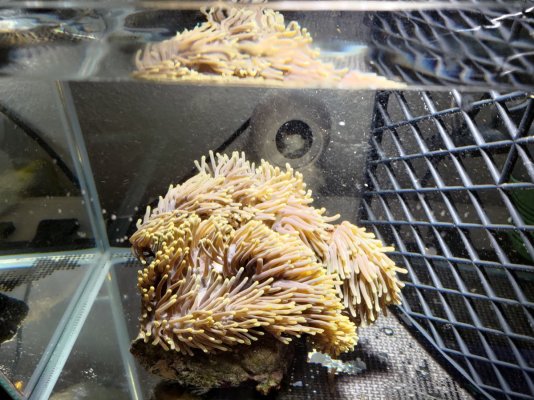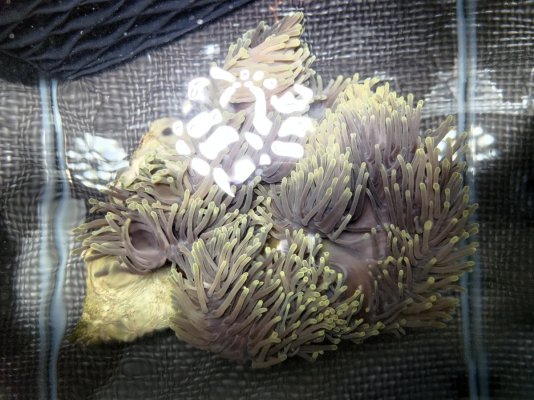This is now void info as antibiotics for fish have been banned. No Cipro will be allowed to be sold unless you go to a vet and get it. Paying a vet fee and whatever they want for the Cipro. They are pulling all antibiotics of every kind off the internet. Looks like message of the day is go buy another one.
Navigation
Install the app
How to install the app on iOS
Follow along with the video below to see how to install our site as a web app on your home screen.
Note: This feature may not be available in some browsers.
More options
You are using an out of date browser. It may not display this or other websites correctly.
You should upgrade or use an alternative browser.
You should upgrade or use an alternative browser.
Protocol for using antibiotics to treat infected anemones
- Thread starter OrionN
- Start date
- Tagged users None
This is now void info as antibiotics for fish have been banned. No Cipro will be allowed to be sold unless you go to a vet and get it. Paying a vet fee and whatever they want for the Cipro. They are pulling all antibiotics of every kind off the internet. Looks like message of the day is go buy another one.
Who is “they”, and furthermore, where? There are 200+ countries, I’m certain not they’re all simultaneously requiring a prescription for antibiotics (which is not “banning”, btw, it’s just an increase in regulation). Even if obtaining antibiotics did require a prescription in your particular country and/or region, then you and/or other hobbyists could obtain a prescription and utilize this protocol.
In light of the above, I fail to see how this information (nor any other antibiotic protocols in our hobby) is “void”.
By the way, this protocol isn’t for the treatment of fish, it’s for the treatment of anemones.
- Joined
- Sep 28, 2019
- Messages
- 1,637
- Reaction score
- 1,090
Well, not in the US, yet. You must be in CanadaThis is now void info as antibiotics for fish have been banned. No Cipro will be allowed to be sold unless you go to a vet and get it. Paying a vet fee and whatever they want for the Cipro. They are pulling all antibiotics of every kind off the internet. Looks like message of the day is go buy another one.
I healed my torn, badly, green BTA with this and I was amazed!!! I lost so many before.This is a re-post of what I wrote in ReefCentral on 3/09/2013
Many anemone keepers know, the collection and shipping process from ocean to local fish store (LFS) is a stressful event. Most host anemones do not survive this process without help, especially H. magnifica and S. gigantea. Other host anemones also have high mortality. Most succumb to infection in the first 4 weeks on arrival to LFS. With help from other anemone keepers at ReefCentral.com Anemones and Clownfish Forum, I have come up with an antibiotic protocol that seems to be successful and drastically improve the initial survival of anemones during this critical time.
The antibiotic choice: Ciprofloxacin (Cipro), a floroquinone antibiotic or Trimethoprim/sulfamethoxazole (Septra) combination antibiotic
There are several reasons I choose these antibiotics. They are broad spectrum antibiotics that should, hopefully, cover most pathogens involved. These antibiotics covered most of the pathogens involved in a saltwater wound infection in humans. This is not to say that pathogen that infected the anemones are the same ones that infected human. However, we have to start somewhere and these two antibiotic are reasonable choices. The other reason for choosing these antibiotic is that they are inexpensive and widely available. Cipro and Septra dissolve well in water and will break down with light exposure in a tank environment. Another antibiotic that can be use is levofloxacin (Levaquin). However, Levaquin is a newer fluroquinone and much more expensive because generic are not available.
Instruction:
The dosage for continuous exposure (not dipping) in a hospital tank is Cipro 250 mg or Septra 160/800 mg per every 10 gal of water. I recommended that anemone be treated in hospital tank. I used a standard 20 gallon (high) tank, power head (PH) , heater, egg crate and possibly an air stone. I also recommended that full light is provide for the anemone to help it recover via photosynthesis. The hospital tank is divide into two compartments by the egg crate. Place the anemone with an inert object (a mug or a medium piece of rock) for it to attach to in one compartment. In the other compartment place the heater, PH and +/-air stone.
Fill the hospital tank half way (10 gal) and added either Septra or Cipro, then added the sick anemone. The hospital tank water needs to be keep stable with respect to temperature and salinity. I recommend that all the water in hospital tank be change daily as the day-time cycle comes to an end. After a water change add antibiotic. The best method to add antibiotic into the hospital tank is to rub the tablet between thumb and index finger in front of the PH until fully dissolved. With reasonable light, it is likely that all or most of the antibiotic will be degraded by the end of the day-time cycle. Adding medication at the begin of the night-time cycle, should give optimal antibiotic exposure for the anemone for most of the 24 hour time period. Adequate circulation, with small PH, is a must. The hospital tank will have a minimal ability to process ammonia, therefore feeding sick anemone is not recommended during treatment process. I do not recommend tapering the dosage of the antibiotic because low level antibiotic treatment is what causes problems and creates resistant strains of bacteria.
Anemones often discharge various substance when they are not well. When the hospital tank water have solid discharge, I recommend removal of these discharge. At any time, if the water of the hospital tank is cloudy, I recommend a 100% water change and new antibiotic added.
Length of treatment:
It is recommended that the anemone is treated for a minimum of 7 days, and at least 3 days after it stops deflating. Early termination of treatment is a mistake that has caused me to loose a few anemones.
Disposal of antibiotic containing water:
There is no special treatment needed for disposing water containing antibiotics. Cipro and Septra will break down quickly with light exposure and will not stay around long in the environment. Short course of antibiotic use like in this protocol should not have significant impact on the environment. It is harmful for the environment if there is a continuous low level antibiotic discharge, but not for short courses like in this protocol . In human usage, these two antibiotics are eliminated unchanged by the kidney, and flushed down the toilet into the sewage system, which is what we are doing with our treatment water. It is unclear if treatment by bleach will do anything to the antibiotic. If you are concerned, store the water and put it under sunlight for a few days then discard.
I clean the hospital tank and all equipment thoroughly include bleaching the full set up in fresh water. Once thoroughly cleaned, the hospital tank can be dry and put into storage until needed.
Question, think it would help a starfish?
Hello,
thanks for all the great info in these threads. I introduced a Heteractis Magnifica into my display 3 weeks ago. After half a day it "accepted" its spot on a flat rock under a 6500k spotlight and looked great:
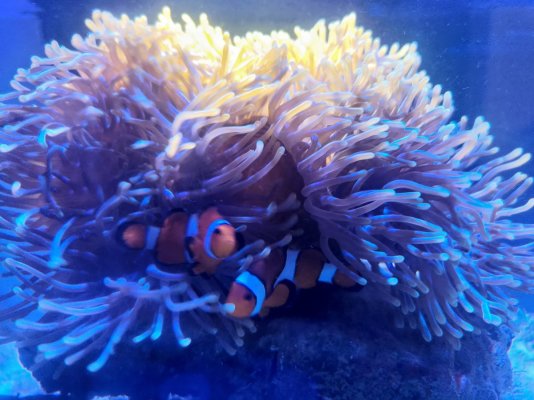
Then 2.5 weeks later it deflated in a matter of minutes during the afternoon, some deflated tentacles:
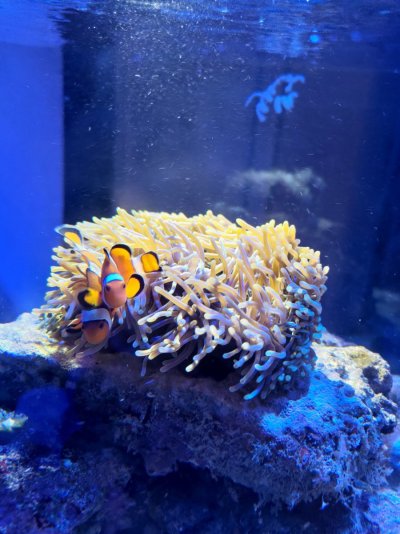
The next day it was back to normal.
Another 3 days later it deflated again during the afternoon in a matter of minutes and a bit of its mouth started to show. This was yesterday. For some reason the clowns also started shoving their heads into its mouth for some reason.
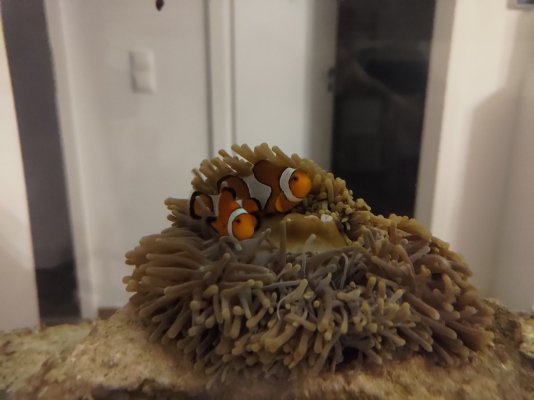
Also I noticed some other corals looking sad immediately after the anemone deflates:
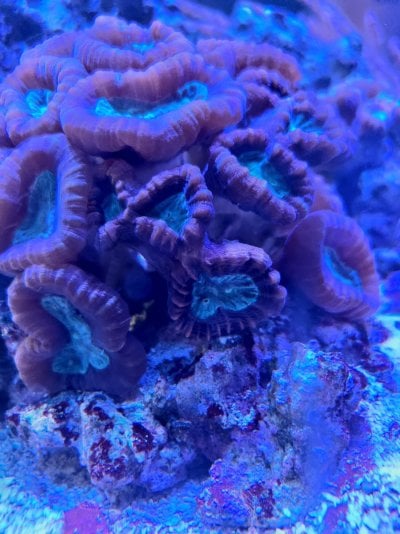
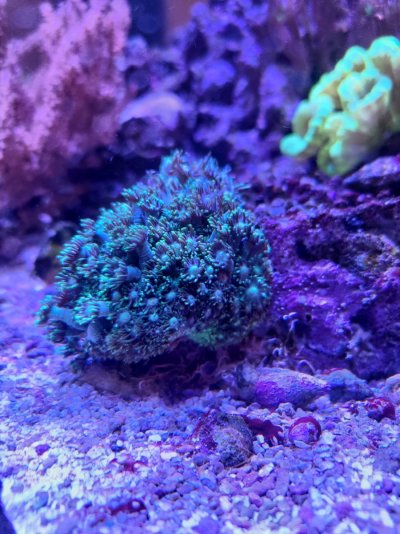
Today it is back to normal again:
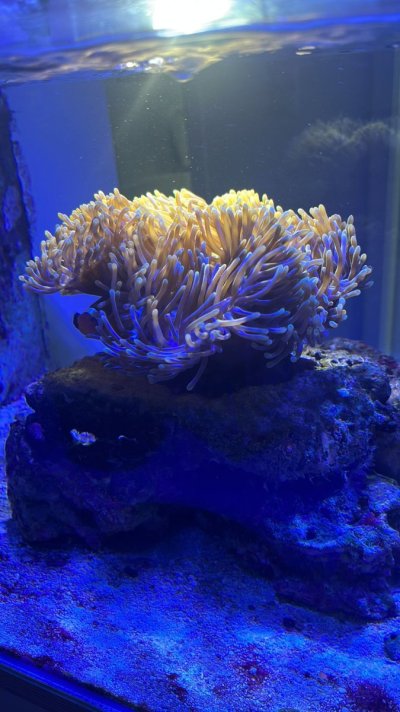
@OrionN I guess I should treat him with Cipro? Trying to get a prescription via a dentist but not so easy in Germany...My brother will visit from the US in 2 weeks and will bring Cipro but I am afraid this will be too late.
I have heard Chemiclean and Red Dino RX are antibiotics. Those would be available to me. Could one of those maybe help him as well?
Really looking forward to your advice!
thanks for all the great info in these threads. I introduced a Heteractis Magnifica into my display 3 weeks ago. After half a day it "accepted" its spot on a flat rock under a 6500k spotlight and looked great:

Then 2.5 weeks later it deflated in a matter of minutes during the afternoon, some deflated tentacles:

The next day it was back to normal.
Another 3 days later it deflated again during the afternoon in a matter of minutes and a bit of its mouth started to show. This was yesterday. For some reason the clowns also started shoving their heads into its mouth for some reason.

Also I noticed some other corals looking sad immediately after the anemone deflates:


Today it is back to normal again:

@OrionN I guess I should treat him with Cipro? Trying to get a prescription via a dentist but not so easy in Germany...My brother will visit from the US in 2 weeks and will bring Cipro but I am afraid this will be too late.
I have heard Chemiclean and Red Dino RX are antibiotics. Those would be available to me. Could one of those maybe help him as well?
Really looking forward to your advice!
- Joined
- May 13, 2017
- Messages
- 2,453
- Reaction score
- 1,280
Have you measured par and spectrum under that light? Could it simply be its getting Photon exhausted? In other words over saturated with light?Hello,
thanks for all the great info in these threads. I introduced a Heteractis Magnifica into my display 3 weeks ago. After half a day it "accepted" its spot on a flat rock under a 6500k spotlight and looked great:

Then 2.5 weeks later it deflated in a matter of minutes during the afternoon, some deflated tentacles:

The next day it was back to normal.
Another 3 days later it deflated again during the afternoon in a matter of minutes and a bit of its mouth started to show. This was yesterday. For some reason the clowns also started shoving their heads into its mouth for some reason.

Also I noticed some other corals looking sad immediately after the anemone deflates:


Today it is back to normal again:

@OrionN I guess I should treat him with Cipro? Trying to get a prescription via a dentist but not so easy in Germany...My brother will visit from the US in 2 weeks and will bring Cipro but I am afraid this will be too late.
I have heard Chemiclean and Red Dino RX are antibiotics. Those would be available to me. Could one of those maybe help him as well?
Really looking forward to your advice!
Highly unlikely with a mag imoHave you measured par and spectrum under that light? Could it simply be its getting Photon exhausted? In other words over saturated with light?
Its just an 8w reflector led spot in addition to my hydra 32s which run on 70%.. Got the Cipro prescription. Nem is still looking good today, just very few slightly less voluminous tentacles...not sure if I should treat with Cipro..
edit:
This evening, as if nothing ever happened:
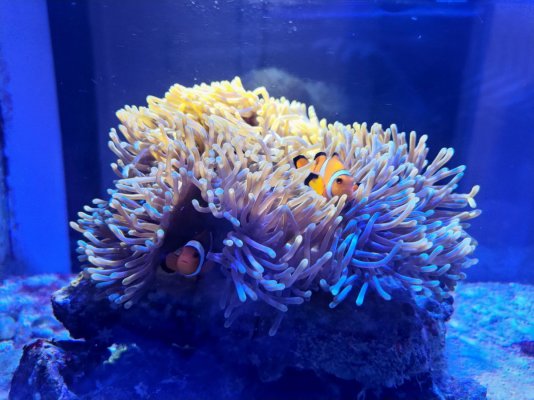
I am just afraid that the deflation cycle will come back worse. I read so many times that people regret not doing Cipro treatment earlier...but it looks so healthy right now that it feels wrong to treat it with antibiotics. What do you guys recommend?
Also noticing some Cyano growth suddenly today as if it was caused by the anemone deflating and releasing its pathogens to the tank.
edit:
This evening, as if nothing ever happened:

I am just afraid that the deflation cycle will come back worse. I read so many times that people regret not doing Cipro treatment earlier...but it looks so healthy right now that it feels wrong to treat it with antibiotics. What do you guys recommend?
Also noticing some Cyano growth suddenly today as if it was caused by the anemone deflating and releasing its pathogens to the tank.
Last edited:
- Joined
- May 13, 2017
- Messages
- 2,453
- Reaction score
- 1,280
I wouldn't think cyano would be triggered from pathogen expulsion, possibly puked up undigested food is a possibility.Its just an 8w reflector led spot in addition to my hydra 32s which run on 70%.. Got the Cipro prescription. Nem is still looking good today, just very few slightly less voluminous tentacles...not sure if I should treat with Cipro..
edit:
This evening, as if nothing ever happened:

I am just afraid that the deflation cycle will come back worse. I read so many times that people regret not doing Cipro treatment earlier...but it looks so healthy right now that it feels wrong to treat it with antibiotics. What do you guys recommend?
Also noticing some Cyano growth suddenly today as if it was caused by the anemone deflating and releasing its pathogens to the tank.
People are running cipro in tank these days , but I never tried that approach. As far as the light, I've had news get very unhappy from both spectrum and intensity.
Last year I lost a 14 inch Colorado sunburst to lights in my main sps display. It had escape a nem holding box. It got down into the rocks and I could not recover it. For the first 4-5 months it looked fantastic. Then it suddenly started acting exactly as your nem is now. Finally moved under the rocks then disappeared. The other 7 are in the same system but the sump. Different lighting.
Deflated today again although only some tentacles are deflated. Mouth is showing again though. I think I will start the Cipro treatment now or does anyone think thats a bad idea? @OrionN ?
I think it’s a good idea. I have great luck with Ciprofloxacin and mags. Unfortunately, it’s never helped any of my gigsDeflated today again although only some tentacles are deflated. Mouth is showing again though. I think I will start the Cipro treatment now or does anyone think thats a bad idea? @OrionN ?
Here we go.. picture taken this morning before lights on. It has been sitting in the Cipro for 10 hours. The filter is only used for aeration, no filtration.I think it’s a good idea. I have great luck with Ciprofloxacin and mags. Unfortunately, it’s never helped any of my gigs
It's really weak and has basically no suction but there is no disadvantage to moving it behind the egg crate... There just wasn't any space for it the way I fixated the egg crate but I will figure somethign out asap. I use it because I am afraid of O2 depletion. I had to move the anemones liverock and a lot of bacteria is going to die in the 5 gallons of water..
What about doxycycline? Can this be used? Wondering because I have some and the aqua cipro is $50 which I rather not purchase if possible and will take a few days to get here. Thank you!This is a re-post of what I wrote in ReefCentral on 3/09/2013
Many anemone keepers know, the collection and shipping process from ocean to local fish store (LFS) is a stressful event. Most host anemones do not survive this process without help, especially H. magnifica and S. gigantea. Other host anemones also have high mortality. Most succumb to infection in the first 4 weeks on arrival to LFS. With help from other anemone keepers at ReefCentral.com Anemones and Clownfish Forum, I have come up with an antibiotic protocol that seems to be successful and drastically improve the initial survival of anemones during this critical time.
The antibiotic choice: Ciprofloxacin (Cipro), a floroquinone antibiotic or Trimethoprim/sulfamethoxazole (Septra) combination antibiotic
There are several reasons I choose these antibiotics. They are broad spectrum antibiotics that should, hopefully, cover most pathogens involved. These antibiotics covered most of the pathogens involved in a saltwater wound infection in humans. This is not to say that pathogen that infected the anemones are the same ones that infected human. However, we have to start somewhere and these two antibiotic are reasonable choices. The other reason for choosing these antibiotic is that they are inexpensive and widely available. Cipro and Septra dissolve well in water and will break down with light exposure in a tank environment. Another antibiotic that can be use is levofloxacin (Levaquin). However, Levaquin is a newer fluroquinone and much more expensive because generic are not available.
Instruction:
The dosage for continuous exposure (not dipping) in a hospital tank is Cipro 250 mg or Septra 160/800 mg per every 10 gal of water. I recommended that anemone be treated in hospital tank. I used a standard 20 gallon (high) tank, power head (PH) , heater, egg crate and possibly an air stone. I also recommended that full light is provide for the anemone to help it recover via photosynthesis. The hospital tank is divide into two compartments by the egg crate. Place the anemone with an inert object (a mug or a medium piece of rock) for it to attach to in one compartment. In the other compartment place the heater, PH and +/-air stone.
Fill the hospital tank half way (10 gal) and added either Septra or Cipro, then added the sick anemone. The hospital tank water needs to be keep stable with respect to temperature and salinity. I recommend that all the water in hospital tank be change daily as the day-time cycle comes to an end. After a water change add antibiotic. The best method to add antibiotic into the hospital tank is to rub the tablet between thumb and index finger in front of the PH until fully dissolved. With reasonable light, it is likely that all or most of the antibiotic will be degraded by the end of the day-time cycle. Adding medication at the begin of the night-time cycle, should give optimal antibiotic exposure for the anemone for most of the 24 hour time period. Adequate circulation, with small PH, is a must. The hospital tank will have a minimal ability to process ammonia, therefore feeding sick anemone is not recommended during treatment process. I do not recommend tapering the dosage of the antibiotic because low level antibiotic treatment is what causes problems and creates resistant strains of bacteria.
Anemones often discharge various substance when they are not well. When the hospital tank water have solid discharge, I recommend removal of these discharge. At any time, if the water of the hospital tank is cloudy, I recommend a 100% water change and new antibiotic added.
Length of treatment:
It is recommended that the anemone is treated for a minimum of 7 days, and at least 3 days after it stops deflating. Early termination of treatment is a mistake that has caused me to loose a few anemones.
Disposal of antibiotic containing water:
There is no special treatment needed for disposing water containing antibiotics. Cipro and Septra will break down quickly with light exposure and will not stay around long in the environment. Short course of antibiotic use like in this protocol should not have significant impact on the environment. It is harmful for the environment if there is a continuous low level antibiotic discharge, but not for short courses like in this protocol . In human usage, these two antibiotics are eliminated unchanged by the kidney, and flushed down the toilet into the sewage system, which is what we are doing with our treatment water. It is unclear if treatment by bleach will do anything to the antibiotic. If you are concerned, store the water and put it under sunlight for a few days then discard.
I clean the hospital tank and all equipment thoroughly include bleaching the full set up in fresh water. Once thoroughly cleaned, the hospital tank can be dry and put into storage until needed.
Can you reefers help me? I have problem 20 odd bta they are all largely affected by a bad batch of frozen mysis/ algae bloom there stomachs are all out and I'm in Australia. Can i treat with penicillin v 500mg? In a quarantine tank? I dont want to lose them.What about doxycycline? Can this be used? Wondering because I have some and the aqua cipro is $50 which I rather not purchase if possible and will take a few days to get here. Thank you!
All parameters are in check nothing to explain this in numbers.
Salinity is 1.025
Kh 9
Ph 8.1
Ammonia, Nitrite both 0ppm
Nitrate 5ppm
Phosphate 0.02
Calcium and Magnesium are optimal
They look so unhappy compared to a few weeks ago and this happened after they ate mysis.
Please help
- Joined
- Mar 5, 2018
- Messages
- 1,020
- Reaction score
- 801
yes..from past memory I remember seeing mags were treated with doxy..Be careful with amoxicillin and BTAS they dont seem to like it...What about doxycycline? Can this be used
Similar threads
- Replies
- 9
- Views
- 122
- Replies
- 27
- Views
- 1,073
- Replies
- 2
- Views
- 183










